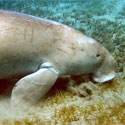|
Sirenia (manatees and dugongs)
Life
>
Eukaryotes >
Opisthokonta >
Metazoa (animals) > Bilateria > Deuterostomia >
Chordata > Craniata > Vertebrata (vertebrates) >
Gnathostomata (jawed vertebrates) > Teleostomi (teleost
fish) > Osteichthyes (bony fish) > Class:
Sarcopterygii (lobe-finned fish) > Stegocephalia
(terrestrial vertebrates) > Reptiliomorpha > Amniota >
Synapsida (mammal-like reptiles) > Therapsida > Theriodontia
> Cynodontia > Mammalia (mammals)
> Placentalia (placental mammals) >
Afrotheria > Paenungulata > Tethytheria
Modern-day representatives of this order are completely
aquatic with flipper-like forelimbs and no hindlimbs. However, fossils
have been discovered in Jamaica of an extinct species Pezosiren portelli (named by Domning 2001) that had forelimbs and hindlimbs capable of being used
for walking on land, although structural features relating to breathing and
ballast suggest that this species probably spent most of its time in the water.
Families encountered in southern Africa
|
Family: Dugongidae (Dugong Dugong dugon)
Contains a single species,
Dugong dugon (Dugong, Sea cow, Sea pig), found along the coast of East Africa, Red Sea and N Australia.
In southern Africa it is found along the Mozambican coast and the coast
of northern KwaZulu-Natal. |
 |
Families not encountered in southern Africa include the
Protastomidae (representatives extinct, including Prorastomus sirenoides and Pezosiren portelli
both described from fossils discovered in Jamaica - see Domning [2001])
and the Trichechidae (manatees - found
along tropical
Atlantic coasts and adjacent rivers).
Publications
Text by Hamish Robertson
|
